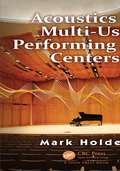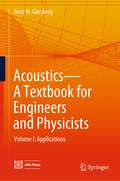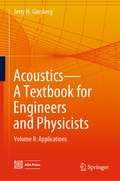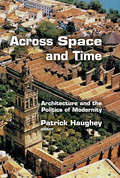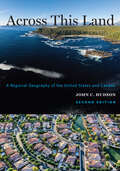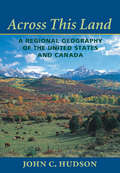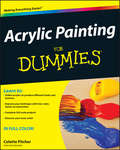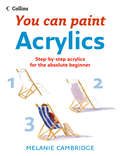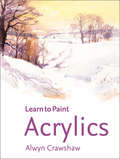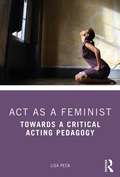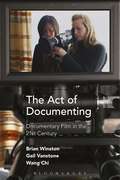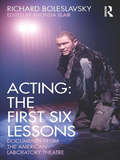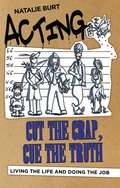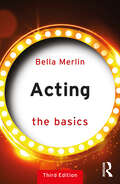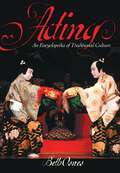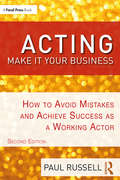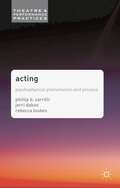- Table View
- List View
Acoustics of Multi-Use Performing Arts Centers
by Mark HoldenMulti-use performing arts centers are among the most complex of all building types and require excellent and flexible acoustics in order to suit the facility's varied programming needs. This technical and practical book by renowned acoustician Mark Holden delivers a full discussion of the challenges and solutions that arise in the concept, design, construction and commissioning phases. It serves students, architects, engineers, designers and acousticians.
Acoustics-A Textbook for Engineers and Physicists: Volume I: Fundamentals
by Jerry H. GinsbergThis graduate and advanced undergraduate textbook systematically addresses all core topics in physical and engineering acoustics. Written by a well-known textbook author with 39 years of experience performing research, teaching, and mentoring in the field, it is specially designed to provide maximum support for learning. Presentation begins from a foundation that does not assume prior study of acoustics and advanced mathematics. Derivations are rigorous, thoroughly explained, and often innovative. Important concepts are discussed for their physical implications and their implementation. Many of the examples are mini case studies that address systems students will find to be interesting and motivating for continued study. Step-by-step explanations accompany example solutions. They address both the significance of the example and the strategy for approaching it. Wherever techniques arise that might be unfamiliar to the reader, they are explained in full. Volume I contains 186 homework exercises, accompanied by a detailed solutions manual for instructors. This text, along with its companion, Volume II: Applications, provides a knowledge base that will enable the reader to begin undertaking research and to work in core areas of acoustics.
Acoustics-A Textbook for Engineers and Physicists: Volume II: Applications
by Jerry H. GinsbergThis textbook provides graduate and advanced undergraduate students with a comprehensive introduction to the application of basic principles and concepts for physical and engineering acoustics. Many of the chapters are independent, and all build from introductory to more sophisticated material. Written by a well-known textbook author with 39 years of experience performing research, teaching, and mentoring in the field, it is specially designed to provide maximum support for learning. Derivations are rigorous and logical, with thorough explanations of operations that are not obvious. Many of the derivations and examples have not previously appeared in print. Important concepts are discussed for their physical implications and implementation. Many of the 56 examples are mini case studies that address systems students will find to be interesting and motivating for continued study. The example solutions address both the significance of the example and the reasoning underlying the formulation. Tasks that require computational work are fully explained. This volume contains 168 homework exercises, accompanied by a detailed solutions manual for instructors. Building on the foundation provided in Volume I: Fundamentals, this text offers a knowledge base that will enable the reader to begin undertaking research and to work in the core areas of acoustics.
Across Space and Time: Architecture and the Politics of Modernity
by Patrick HaugheyModernity tends to be considered a mostly Western, chronologically recent concept. Looking at locations in Brazil, Java, India, Georgia, and Yugoslavia, among others, Across Space and Time provides architectural and cultural evidence that modernity has had an impact across the globe and for much longer than previously conceived. This volume moves through space and time to illustrate the way global modernity has been negotiated through architecture, urban planning, design pedagogies, preservation, and art history in diverse locations around the world. Bringing together emerging and established architecture and art history scholars, each chapter focuses on a particular site where modernity was defined, challenged, or reinterpreted. The contributors examine how architectures, landscapes, and design thinking influence and are influenced by conflicts between cultural, economic, technological, and political forces. By invoking well-researched histories to ground their work in a post-colonial critique, they closely examine many prevailing myths of modernity. Notable topics include emerging architectural history in the Indian subcontinent and the connection between climate change and architecture. Ultimately, Across Space and Time contributes to the ongoing critique of architecture and its history, both as a discipline and within the academy. The authors insist that architecture is more than a style. It is a powerful expression of representational power that reveals how a society negotiates its progress.
Across Space and Time: Architecture and the Politics of Modernity
by Patrick HaugheyModernity tends to be considered a mostly Western, chronologically recent concept. Looking at locations in Brazil, Java, India, Georgia, and Yugoslavia, among others, Across Space and Time provides architectural and cultural evidence that modernity has had an impact across the globe and for much longer than previously conceived. This volume moves through space and time to illustrate the way global modernity has been negotiated through architecture, urban planning, design pedagogies, preservation, and art history in diverse locations around the world. Bringing together emerging and established architecture and art history scholars, each chapter focuses on a particular site where modernity was defined, challenged, or reinterpreted. The contributors examine how architectures, landscapes, and design thinking influence and are influenced by conflicts between cultural, economic, technological, and political forces. By invoking well-researched histories to ground their work in a post-colonial critique, they closely examine many prevailing myths of modernity. Notable topics include emerging architectural history in the Indian subcontinent and the connection between climate change and architecture. Ultimately, Across Space and Time contributes to the ongoing critique of architecture and its history, both as a discipline and within the academy. The authors insist that architecture is more than a style. It is a powerful expression of representational power that reveals how a society negotiates its progress.
Across This Land: A Regional Geography of the United States and Canada (Creating the North American Landscape)
by John HudsonBased on decades of research and written in clear, concise prose by one of the foremost geographers in North America, John C. Hudson's Across This Land is a comprehensive regional geography of the North American continent. Dividing the terrain into ten regions, which are then subdivided into twenty-seven smaller areas, Hudson's brisk narrative reveals the dynamic processes of each area's distinctive place-specific characteristics. Focusing on how human activities have shaped and have been shaped by the natural environment, Hudson considers physical, political, and historical geography. He also highlights related topics, including resource exploitation, economic development, and population change. Praised in its first edition as a readable and reliable interpretation of United States and Canadian geography, the revised Across This Land retains these strengths while adding substantial new material. Incorporating the latest available population and economic data, this thoroughly updated edition includes• reflections on new developments, such as resource schemes, Native governments in Atlantic Canada, and the role of climate change in the Arctic• a new section focused on the US Pacific insular territories west of Hawaii• evolving views of oil and gas production resulting from the introduction of hydraulic fracturing• revised text and maps involving agricultural production based on the 2017 Census of Agriculture• current place names• more than 130 photographsThe most extensive regional geography of the North American continent on the market, Hudson's Across This Land will continue as the standard text in geography courses dealing with Canada and the United States, as well as a popular reference work for scholars, students, and lay readers.
Across This Land: A Regional Geography of the United States and Canada (Creating the North American Landscape)
by John C. HudsonBased on decades of research and written in clear, concise prose by one of the foremost geographers in North America, John C. Hudson's Across This Land is a comprehensive regional geography of the North American continent.Clearly organized, the book divides the entire United States and Canada into six major regions, then further subdivides them into twelve smaller areas. Hudson emphasizes each region or area's distinguishing place-specific attributes, including—to a larger degree than previous regional geographies—political considerations. In this way, the book tells the story of each region, relying on a brisk narrative that reveals the dynamic processes of their distinctive characteristics. The first extensive regional geography of the North American continent in over seventy-five years, Hudson's Across This Land will become the standard text in geography courses dealing with Canada and the U.S. as well as a popular reference work for scholars, students, and lay readers.
Across This Land: A Regional Geography of the United States and Canada (Creating the North American Landscape)
by John HudsonBased on decades of research and written in clear, concise prose by one of the foremost geographers in North America, John C. Hudson's Across This Land is a comprehensive regional geography of the North American continent. Dividing the terrain into ten regions, which are then subdivided into twenty-seven smaller areas, Hudson's brisk narrative reveals the dynamic processes of each area's distinctive place-specific characteristics. Focusing on how human activities have shaped and have been shaped by the natural environment, Hudson considers physical, political, and historical geography. He also highlights related topics, including resource exploitation, economic development, and population change. Praised in its first edition as a readable and reliable interpretation of United States and Canadian geography, the revised Across This Land retains these strengths while adding substantial new material. Incorporating the latest available population and economic data, this thoroughly updated edition includes• reflections on new developments, such as resource schemes, Native governments in Atlantic Canada, and the role of climate change in the Arctic• a new section focused on the US Pacific insular territories west of Hawaii• evolving views of oil and gas production resulting from the introduction of hydraulic fracturing• revised text and maps involving agricultural production based on the 2017 Census of Agriculture• current place names• more than 130 photographsThe most extensive regional geography of the North American continent on the market, Hudson's Across This Land will continue as the standard text in geography courses dealing with Canada and the United States, as well as a popular reference work for scholars, students, and lay readers.
Acrylic Painting For Dummies
by Colette PitcherHands-on, full-color instruction in this versatile painting medium Acrylic paint is easy to use, quick to dry, a cinch to clean up, and relatively inexpensive–which makes it a great medium for amateur artists. Following a simple step-by-step approach, Acrylic Painting For Dummies provides hands-on instruction and easy-to-follow exercises in acrylic painting techniques and styles, making the medium accessible to would-be artists at all levels. Featuring large-scale projects at the end of most chapters and ample additional opportunities for readers to paint along, this friendly guide will help anyone discover the artist within.
Acrylic Painting For Dummies
by Colette PitcherHands-on, full-color instruction in this versatile painting medium Acrylic paint is easy to use, quick to dry, a cinch to clean up, and relatively inexpensive–which makes it a great medium for amateur artists. Following a simple step-by-step approach, Acrylic Painting For Dummies provides hands-on instruction and easy-to-follow exercises in acrylic painting techniques and styles, making the medium accessible to would-be artists at all levels. Featuring large-scale projects at the end of most chapters and ample additional opportunities for readers to paint along, this friendly guide will help anyone discover the artist within.
Acrylics: A Step-by-step Guide For Absolute Beginners (Collins You Can Paint)
by Melanie CambridgeThis book assumes no prior knowledge or experience and guides the beginner painter step-by-step through the basics of painting in acrylics.
Acrylics (Learn to Paint)
by Alwyn CrawshawLearn to Paint Acrylics is just one of the top-selling titles in the excellent Collins Learn to Paint series. The book contains thorough yet accessible instruction and stunning artwork by popular TV artist, Alwyn Crawshaw.
Act as a Feminist: Towards a Critical Acting Pedagogy
by Lisa PeckAct as a Feminist maps a female genealogy of UK actor training practices from 1970 to 2020 as an alternative to traditional male lineages. It re-orientates thinking about acting through its intersections with feminisms and positions it as a critical pedagogy, fit for purpose in the twenty-first century. The book draws attention to the pioneering contributions women have made to actor training, highlights the importance of recognising the political potential of acting, and problematises the inequities for a female majority inspired to work in an industry where they remain a minority. Part One opens up the epistemic scope, shaping a methodology to evaluate the critical potential of pedagogic practice. It argues that feminist approaches offer an alternative affirmative position for training, a via positiva and a way to re-make mimesis. In Part Two, the methodology is applied to the work of UK women practitioners through analysis of the pedagogic exchange in training grounds. Each chapter focuses on how the broad curriculum of acting intersects with gender as technique to produce a hidden curriculum, with case studies on Jane Boston and Nadine George (voice), Niamh Dowling and Vanessa Ewan (movement), Alison Hodge and Kristine Landon-Smith (acting), and Katie Mitchell and Emma Rice (directing). The book concludes with a feminist manifesto for change in acting. Written for students, actors, directors, teachers of acting, voice, and movement, and anyone with an interest in feminisms and critical pedagogies, Act as a Feminist offers new ways of thinking and approaches to practice.
Act as a Feminist: Towards a Critical Acting Pedagogy
by Lisa PeckAct as a Feminist maps a female genealogy of UK actor training practices from 1970 to 2020 as an alternative to traditional male lineages. It re-orientates thinking about acting through its intersections with feminisms and positions it as a critical pedagogy, fit for purpose in the twenty-first century. The book draws attention to the pioneering contributions women have made to actor training, highlights the importance of recognising the political potential of acting, and problematises the inequities for a female majority inspired to work in an industry where they remain a minority. Part One opens up the epistemic scope, shaping a methodology to evaluate the critical potential of pedagogic practice. It argues that feminist approaches offer an alternative affirmative position for training, a via positiva and a way to re-make mimesis. In Part Two, the methodology is applied to the work of UK women practitioners through analysis of the pedagogic exchange in training grounds. Each chapter focuses on how the broad curriculum of acting intersects with gender as technique to produce a hidden curriculum, with case studies on Jane Boston and Nadine George (voice), Niamh Dowling and Vanessa Ewan (movement), Alison Hodge and Kristine Landon-Smith (acting), and Katie Mitchell and Emma Rice (directing). The book concludes with a feminist manifesto for change in acting. Written for students, actors, directors, teachers of acting, voice, and movement, and anyone with an interest in feminisms and critical pedagogies, Act as a Feminist offers new ways of thinking and approaches to practice.
The Act of Documenting: Documentary Film in the 21st Century
by Brian Winston Gail Vanstone Wang ChiDocumentary has never attracted such audiences, never been produced with such ease from so many corners of the globe, never embraced such variety of expression. The very distinctions between the filmed, the filmer and the spectator are being dissolved. The Act of Documenting addresses what this means for documentary's 21st century position as a genus in the “class” cinema; for its foundations as, primarily, a scientistic, eurocentric and patriarchal discourse; for its future in a world where assumptions of photographic image integrity cannot be sustained. Unpacked are distinctions between performance and performativy and between different levels of interaction, linearity and hypertextuality, engagement and impact, ethics and conditions of reception. Winston, Vanstone and Wang Chi explore and celebrate documentary's potentials in the digital age.
The Act of Documenting: Documentary Film in the 21st Century
by Brian Winston Gail Vanstone Wang ChiDocumentary has never attracted such audiences, never been produced with such ease from so many corners of the globe, never embraced such variety of expression. The very distinctions between the filmed, the filmer and the spectator are being dissolved. The Act of Documenting addresses what this means for documentary's 21st century position as a genus in the “class” cinema; for its foundations as, primarily, a scientistic, eurocentric and patriarchal discourse; for its future in a world where assumptions of photographic image integrity cannot be sustained. Unpacked are distinctions between performance and performativy and between different levels of interaction, linearity and hypertextuality, engagement and impact, ethics and conditions of reception. Winston, Vanstone and Wang Chi explore and celebrate documentary's potentials in the digital age.
Acting: Documents from the American Laboratory Theatre
by Richard Boleslavsky Rhonda BlairActing: The First Six Lessons was first published in 1933 and remains a key text for anyone studying acting today. These dramatic dialogues between teacher and idealistic student explore the field of acting according to one of the original teachers of Stanislavsky’s System in America. This new edition of an essential text is edited by Rhonda Blair and supplemented for the very first time with documents from the American Laboratory Theatre. These collect together a broad range of exciting unpublished material, drawn from Boleslavsky’s pivotal and unprecedented teachings on acting at the American Laboratory Theatre. Included are: "The Creative Theatre Lectures" by Richard Boleslavsky Boleslavsky’s "Lectures from the American Laboratory Theatre" "Acting with Maria Ouspenskaya," four short essays on the work of Ouspenskaya, Boleslavsky’s colleague and fellow actor trainer A new critical introduction and bibliography by the Editor.
Acting: Documents from the American Laboratory Theatre
by Richard Boleslavsky Rhonda BlairActing: The First Six Lessons was first published in 1933 and remains a key text for anyone studying acting today. These dramatic dialogues between teacher and idealistic student explore the field of acting according to one of the original teachers of Stanislavsky’s System in America. This new edition of an essential text is edited by Rhonda Blair and supplemented for the very first time with documents from the American Laboratory Theatre. These collect together a broad range of exciting unpublished material, drawn from Boleslavsky’s pivotal and unprecedented teachings on acting at the American Laboratory Theatre. Included are: "The Creative Theatre Lectures" by Richard Boleslavsky Boleslavsky’s "Lectures from the American Laboratory Theatre" "Acting with Maria Ouspenskaya," four short essays on the work of Ouspenskaya, Boleslavsky’s colleague and fellow actor trainer A new critical introduction and bibliography by the Editor.
Acting: Living the Life and Doing the Job (The Actor's Toolkit)
by Natalie BurtActing: Cut the Crap, Cue the Truth fills a gap in the drama school curriculum, tackling many areas which are unaddressed during training and discussing issues that are more often than not hushed up afterwards. Starting from the vital final stages of training, and on to life as a professional, Natalie Burt – a young, jobbing actress – moves systematically through the challenges that every actor faces; from making strategic career decisions, to the logistics of TV and film sets and voice over work, to more personal matters such as renting and flat-sharing, finance and well-being when out of work. Rejecting gimmicks and quick fixes, she encourages motivational thinking and entrepreneurialism using an informal, unapologetic and humorous tone whilst sharing information that is current, relevant and from the frontline.Or, as Natalie puts it, ‘a thorough, constructive and ball-achingly honest chat about the industry, written by someone who still has all their own teeth.’Contributors to the book include Spotlight, Equity, James Penford from Hatton McEwan Penford agency and Alice Purser from Andy Pryor Casting.Endorsements:‘What Natalie Burt has done here is remarkable. She has written a luminously honest, very funny, often very touching voyage of what it is actually like to be afflicted with the unquenchable desire to dedicate oneself to being a professional actor.’ Timothy Spall O.B.E(ese)‘A refreshing and entertaining take on the challenges facing actors and how best to surmount them.’ Ben Seale, Managing Partner, Spotlight‘Natalie’s book is like her acting: playful, irreverent, and accomplished. An invaluable resource.’ Laurie Sansom, Artistic Director, National Theatre of Scotland‘At last! The book all aspiring actors have been waiting for. A truthful, comprehensive, funny guide to life as a jobbing and sometimes not jobbing actor.’ Caroline Quentin‘The best book ever written.’ Natalie’s mum
Acting: The Basics (The Basics)
by Bella MerlinActing: The Basics 3rd Edition is a dynamic response to recent societal and entertainment industry changes, focusing on inclusion, diversity and equity, and the actor's trajectory from training to rehearsal to performance on stage and screen, with hands-on tools and global perspectives. The book offers vital ways of building a practical acting toolkit, through breath, body, voice, emotions, imagination and spirit. We begin with a socio-cultural look at actor as magician, storyteller, healer and social changer. Throughout, there are insights from Black, Indigenous, First Nations, South/East Asian, intercultural and feminist practitioners, together with methods focusing on disability and accessibility, intimacy directives, mindfulness and intersectionality. Key 'canonical' figures still feature (e.g., Stanislavsky, Meisner, Brecht and Suzuki) with re-visioned perspective. Scattered throughout are post-COVID insights, plus expanded sections on screen acting (including self-tapes) and Shakespeare. This book is useful for beginner or expert, as it's always helpful getting back to basics. Because the author is both an actor and an actor trainer, the tools are steeped in user-friendly application. At the same time, transferable skills (e.g., dynamic listening and empathy) are shown as relevant to everyone. With a glossary of terms and useful online suggestions (including blogs, videos and podcasts), this is ideal for anyone learn anew about the practice and history of acting, or to take their acting and teaching into new terrain.
Acting: The Basics (The Basics)
by Bella MerlinActing: The Basics 3rd Edition is a dynamic response to recent societal and entertainment industry changes, focusing on inclusion, diversity and equity, and the actor's trajectory from training to rehearsal to performance on stage and screen, with hands-on tools and global perspectives. The book offers vital ways of building a practical acting toolkit, through breath, body, voice, emotions, imagination and spirit. We begin with a socio-cultural look at actor as magician, storyteller, healer and social changer. Throughout, there are insights from Black, Indigenous, First Nations, South/East Asian, intercultural and feminist practitioners, together with methods focusing on disability and accessibility, intimacy directives, mindfulness and intersectionality. Key 'canonical' figures still feature (e.g., Stanislavsky, Meisner, Brecht and Suzuki) with re-visioned perspective. Scattered throughout are post-COVID insights, plus expanded sections on screen acting (including self-tapes) and Shakespeare. This book is useful for beginner or expert, as it's always helpful getting back to basics. Because the author is both an actor and an actor trainer, the tools are steeped in user-friendly application. At the same time, transferable skills (e.g., dynamic listening and empathy) are shown as relevant to everyone. With a glossary of terms and useful online suggestions (including blogs, videos and podcasts), this is ideal for anyone learn anew about the practice and history of acting, or to take their acting and teaching into new terrain.
Acting: An International Encyclopedia of Traditional Culture (Arts Of Living Ser.)
by Mary Beth OsnesA groundbreaking, cross-cultural reference work exploring the diversity of expression found in rituals, festivals, and performances, uncovering acting techniques and practices from around the world.Acting: An International Encyclopedia explores the amazing diversity of dramatic expression found in rituals, festivals, and live and filmed performances. Its hundreds of alphabetically arranged, fully referenced entries offer insights into famous players, writers, and directors, as well as notable stage and film productions from around the world and throughout the history of theater, cinema, and television.The book also includes a surprising array of additional topics, including important venues (from Greek amphitheaters to Broadway and Hollywood), acting schools (the Actor's Studio) and companies (the Royal Shakespeare), performance genres (from religious pageants to puppetry), technical terms of the actor's art, and much more. It is a unique resource for exploring the techniques performers use to captivate their audiences, and how those techniques have evolved to meet the demands of performing through Greek masks and layers of Kabuki makeup, in vast halls or tiny theaters, or for the unforgiving eye of the camera.
Acting: How to Avoid Mistakes and Achieve Success as a Working Actor
by Paul RussellIn ACTING: Make It Your Business, Second Edition, award-winning casting director Paul Russell puts the power to land jobs and thrive in any medium—stage, film, television, or the Internet—directly into the hands of the actor. This blunt and practical guide offers a wealth of advice on auditioning, marketing, and networking, combining traditional techniques with those best suited for the digital age. Well-known actors and powerful agents and managers make cameos throughout, offering newcomers and working professionals alike a clear-eyed, uncensored perspective on survival and advancement within the entertainment industry. This second edition has been updated and expanded to include the following: More stars of screen and stage sharing acting career strategies Digital audition techniques for screen and stage, including how best to self-tape New tools to master modern marketing, both digital and traditional with innovation Expanded actor resource listings Additional bicoastal talent agents and managers spilling secrets for obtaining representation, and tips for successful actor-to-representation partnerships New insights on audition techniques An excellent resource for career actors, beginning and amateur actors, as well as students in Acting I and II, Auditions, and Business of Acting courses, ACTING: Make It Your Business provides readers with invaluable tools to build a successful, long-lasting acting career.
Acting: How to Avoid Mistakes and Achieve Success as a Working Actor
by Paul RussellIn ACTING: Make It Your Business, Second Edition, award-winning casting director Paul Russell puts the power to land jobs and thrive in any medium—stage, film, television, or the Internet—directly into the hands of the actor. This blunt and practical guide offers a wealth of advice on auditioning, marketing, and networking, combining traditional techniques with those best suited for the digital age. Well-known actors and powerful agents and managers make cameos throughout, offering newcomers and working professionals alike a clear-eyed, uncensored perspective on survival and advancement within the entertainment industry. This second edition has been updated and expanded to include the following: More stars of screen and stage sharing acting career strategies Digital audition techniques for screen and stage, including how best to self-tape New tools to master modern marketing, both digital and traditional with innovation Expanded actor resource listings Additional bicoastal talent agents and managers spilling secrets for obtaining representation, and tips for successful actor-to-representation partnerships New insights on audition techniques An excellent resource for career actors, beginning and amateur actors, as well as students in Acting I and II, Auditions, and Business of Acting courses, ACTING: Make It Your Business provides readers with invaluable tools to build a successful, long-lasting acting career.
Acting: Psychophysical Phenomenon and Process (Theatre and Performance Practices)
by Phillip Zarrilli Jerri Daboo Rebecca LoukesWhat is the relationship between 'body' and 'mind', 'inner' and 'outer' in any approach to acting? How have different modes of actor training shaped actors' experiences of acting and how they understand their work? Phillip B. Zarrilli, Jerri Daboo and Rebecca Loukes offer insight into such questions, analysing acting as a psychophysical phenomenon and process across cultures and disciplines, and providing in-depth accounts of culturally and historically specific approaches to acting. Individual chapters explore: - Psychophysical acting and the legacy of Stanislavsky- European psychophysical practices of dance and theatre- Traditional and contemporary psychophysical approaches to performance in India and Japan- Insights from the new sciences on the 'situated bodymind' of the actor- Intercultural perspectives on acting.This lively study is ideal for students and practitioners alike.
